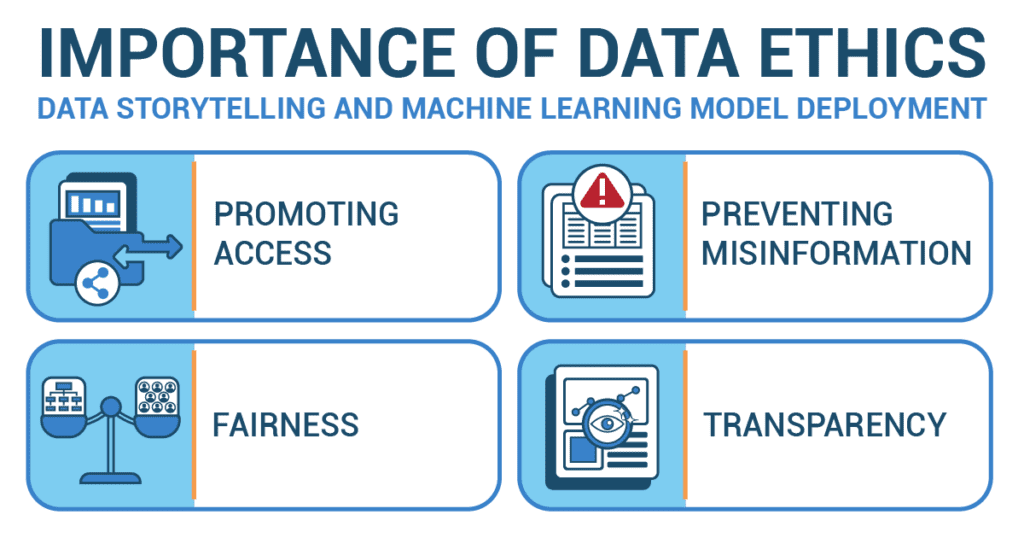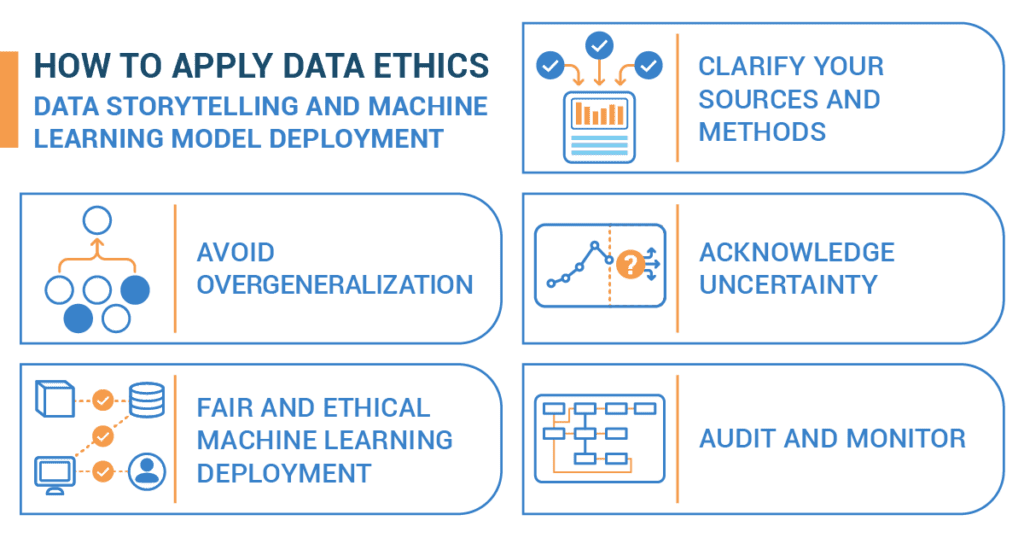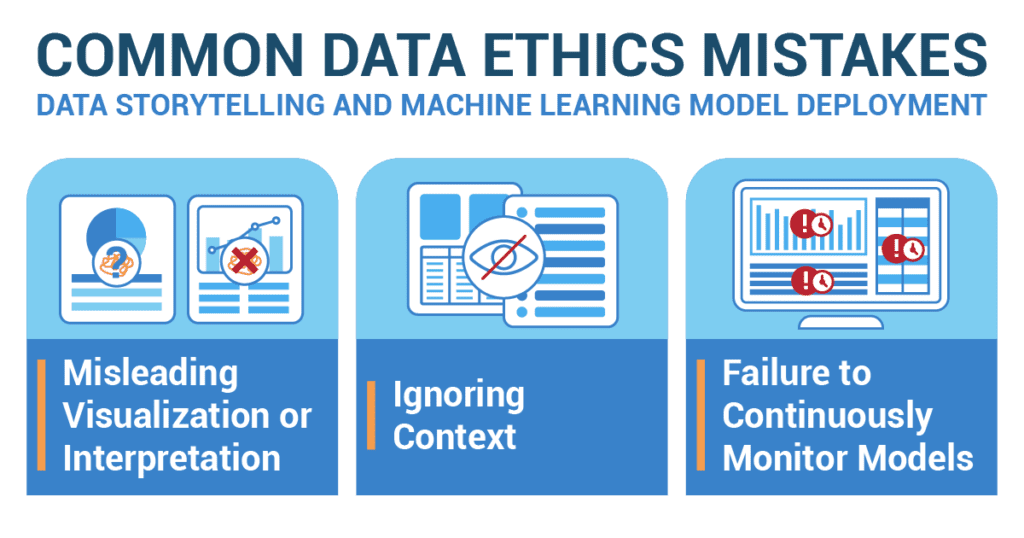Let’s kick off with a question. Have you ever shared a secret? It could be your best friend’s crush, a cherished family recipe, or maybe some spicy gossip. We’ve all been there at some point. You might find this familiar – that moment right before you spill the beans, when you hesitate, pondering whether it’s right to share. That’s your moral compass, doing its thing. Now, picture standing on the edge of revealing not just a single secret but a torrent of them, secrets that could touch millions of lives. Welcome to the daring world of data publication.
Why Should We Care About Data Ethics?
In the dissemination of research findings, akin to the careful handling of confidential information, it is imperative to exercise data ethics. This encompasses facilitating accessibility, mitigating misinformation, upholding fairness, and ensuring transparency.
Consider the scenario where colleagues were unable to attend a critical briefing or presentation. The objective would be to relay the information in a comprehensible and inclusive manner, epitomizing the principle of promoting access. This principle extends to ensuring that the research outcomes are readily available and presented clearly and transparent to all stakeholders, particularly those affected by the findings.
However, the risk of inadvertently conveying inaccurate information—equivalent to misreporting a key detail or outcome of the meeting—highlights the danger of misinformation. Misinterpretation or misrepresentation of data can lead to erroneous conclusions, influencing decisions at various levels, from personal choices to policy formulation.
Moreover, focusing exclusively on the contributions of a particular department while ignoring others mirrors a lack of fairness in data utilization. It is essential to guard against biases in algorithmic decision-making processes, which can exacerbate systemic inequalities and negatively impact critical areas such as credit evaluation, employment selection, and law enforcement practices.
Lastly, transparency is akin to sharing a comprehensive summary of the meeting or presentation. By elucidating the methodologies employed in data analysis, we foster trust in the research outcomes and facilitate the replication of studies. It is crucial that results and models are open to examination and critique, with established mechanisms for addressing ethical concerns post-implementation.
How Do We Apply Data Ethics?
When you’re presenting your findings, here’s what you should do:
Clarify Your Sources and Methods: Clearly explain the origins of your data, how it was collected, and how it was processed. Apply the principle of transparency by being open about the limitations and potential biases in your data and methods. Ensure that the methods and techniques used in the analysis are communicated clearly. The audience should understand the strengths and limitations of your data and models. As part of the AI HLEG Ethics Guidelines for Trustworthy AI, transparency is fundamental. It’s like giving them a behind-the-scenes tour of your detective work!
Avoid Overgeneralization: Don’t make your data sound more convincing than it really is. If you surveyed ten employees about their favorite ice cream flavor, don’t claim to know the favorite flavor of all the employees in your company. This principle of honesty ensures that your audience isn’t misled by the results. While making your findings accessible, be careful not to oversimplify to the point of distortion. It’s crucial to balance accessibility and accuracy. The American Statistical Association’s Ethical Guidelines for Statistical Practice highlight this principle.
Acknowledge Uncertainty: Remember, there’s always a chance your findings might not be 100% correct. Like guessing the mystery flavor of a jelly bean, sometimes you might be right on the nose, other times not so much. It’s important to share this uncertainty with your audience.
In the context of deploying a machine learning model for business purposes, such as an algorithm designed to forecast the outcomes of basketball games by analyzing historical performance data, it is imperative to adopt a comprehensive approach that encompasses ethical considerations and continuous oversight.
Ethical Deployment and Fairness in Machine Learning: It is crucial to ensure that your model operates in a manner that safeguards individual privacy and avoids perpetuating biases. A common pitfall is the inadvertent favoring of certain outcomes based on skewed historical data, which could, for example, lead to a bias against a team with a recent string of losses. Such algorithmic bias stems from reliance on data that may not be representative or fair, highlighting the necessity of diligent construction and monitoring of your models. Adherence to frameworks like Nissenbaum’s concept of privacy as contextual integrity is essential, ensuring that the model’s deployment aligns with the ethical standards and expectations of its operational environment.
Continuous Audit and Performance Monitoring: Beyond the initial development phase, it is essential to actively monitor the model’s performance to confirm it functions as intended. This ongoing evaluation process is akin to a coach’s role in constantly assessing and adjusting their team’s strategy throughout the game. The Institute of Electrical and Electronics Engineers (IEEE), recognized as the largest global professional organization dedicated to advancing technology for societal benefit, advocates for this rigorous approach through its Ethically Aligned Design principles. These guidelines stress the importance of a sustained commitment to auditing and refining machine learning models to uphold ethical standards and operational efficacy.
Incorporating these practices into your machine learning project management will not only enhance the model’s reliability and fairness but also contribute to maintaining your organization’s reputation and compliance with ethical norms in technological deployment.
Watch Out for These Data Ethics Traps!
Just like every detective story has its twists and turns, working with data can sometimes lead us into a few traps. But don’t worry, I’ve got your back! Here are some common data ethics mistakes and how to avoid them.
Misleading Visualization or Interpretation: Let’s say you’ve created a bar graph showing the number of pizzas sold in your office cafeteria. If one bar is way taller than others, it might look like that pizza is super popular. But what if that bar represents a whole month’s sales while others represent just a week? That’s misleading! To avoid this, always follow good practices in making charts and check your work for possible misunderstandings.
Ignoring Context: Imagine you have a model that predicts the best time to hold band practice based on when the band room is usually empty. That model might not work for the choir, which might need the room at different times. Before using your model in a new situation, make sure you understand the differences and adjust your model accordingly.
Failure to Continuously Monitor Models: Let’s go back to the basketball game prediction model. Suppose your model was trained on data from games when a star player was always playing. If that player graduates, your model might start making wrong predictions. That’s why it’s important to keep checking your model to ensure it still works well. Set up automatic systems, if you can, to keep an eye on your model’s performance and impacts.
Remember, becoming a great data detective takes practice. But as long as you stay aware of these potential pitfalls and work to avoid them, you’ll be well on your way!
Ethical Publication in Computer Parts Data Project
In the realm of computer technology, Michael Anderson, a seasoned corporate professional, found himself at a crossroads where innovation met ethical responsibility. His journey revolved around a data project that aimed to revolutionize computer parts manufacturing while upholding the highest standards of data ethics during the publication stage.
Michael’s project was ambitious – to leverage data-driven insights to optimize the design and production of computer parts, from processors to graphic cards. Amid the excitement of technological advancements, he was deeply committed to ensuring that the publication of project findings remained ethically responsible. As the project entered the publication stage, Michael meticulously integrated ethical practices to ensure that the insights shared with the world aligned with responsible, transparent, and inclusive principles.
Understanding the importance of intellectual property rights, Michael was vigilant about transparently attributing the source of data insights. He ensured that the contributions of all team members, as well as external data sources, were accurately acknowledged. This approach not only upheld ethical standards but also promoted a culture of transparency within the industry. Recognizing the potential for bias in interpreting data, Michael ensured that the project’s findings were reported objectively and without exaggeration. He leveraged his corporate communication skills to draft publications that refrained from overhyping the implications of the research, thereby promoting a balanced and honest portrayal of the results.
Incorporating his corporate background, Michael aimed to empower consumers through the publication of the project’s findings. He emphasized the importance of clear and accessible language in the reports, ensuring that consumers could understand the implications of the research and make informed decisions about computer parts. Michael recognized that the project’s findings could have far-reaching ethical implications, including considerations related to e-waste, environmental impact, and societal needs. In the publications, he dedicated sections to discuss these implications openly, providing a holistic view of the potential benefits and challenges posed by the research.
Drawing on his corporate connections, Michael engaged with industry stakeholders to gather feedback before finalizing the publications. He organized workshops and forums to include diverse perspectives and opinions, ensuring that the project’s findings were thoroughly vetted and stood up to ethical scrutiny. Applying his understanding of communication ethics, Michael refrained from using data interpretations out of context or in a way that might mislead readers. He exercised caution to present the findings accurately and responsibly, avoiding any potential misrepresentation.
As the publication stage concluded, Michael’s ethical approach had a profound impact. The project’s findings, now in the public domain, were recognized not just for their technological innovation but also for their ethical integrity. His case study exemplifies the harmonious blend of technological advancement and ethical considerations, showcasing how corporate expertise can drive progress while prioritizing ethical principles. Michael Anderson’s journey through the realm of computer parts, enriched by his corporate acumen, stands as a testament to the power of ethical data publication. His case study underscores the importance of maintaining ethical considerations in all stages of data projects, particularly during the crucial phase of sharing findings with the world.


